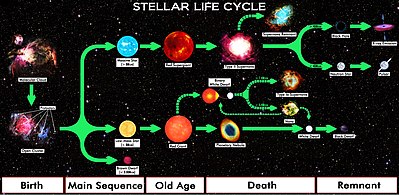
Back Swartdwerg Afrikaans قزم أسود Arabic Чорны карлік Byelorussian Черно джудже Bulgarian কৃষ্ণ বামন Bengali/Bangla Nana negra Catalan Černý trpaslík Czech Sort dværg Danish Schwarzer Zwerg German Μαύρος νάνος Greek

A black dwarf is a theoretical stellar remnant, specifically a white dwarf that has cooled sufficiently to no longer emit significant heat or light. Because the time required for a white dwarf to reach this state is calculated to be longer than the current age of the universe (13.8 billion years), no black dwarfs are expected to exist in the universe at the present time. The temperature of the coolest white dwarfs is one observational limit on the universe's age.[1]
The name "black dwarf" has also been applied to hypothetical late-stage cooled brown dwarfs – substellar objects with insufficient mass (less than approximately 0.07 M☉) to maintain hydrogen-burning nuclear fusion.[2][3][4][5]
- ^ Heger, A.; Fryer, C. L.; et al. (2003). "How Massive Single Stars End Their Life". The Astrophysical Journal. 591 (1): 288–300. arXiv:astro-ph/0212469. Bibcode:2003ApJ...591..288H. doi:10.1086/375341. S2CID 59065632. Retrieved 25 March 2022.
- ^ Jameson, R. F.; Sherrington, M. R.; Giles, A.R. (October 1983). "A failed search for black dwarfs as companions to nearby stars". Monthly Notices of the Royal Astronomical Society. 205: 39–41. Bibcode:1983MNRAS.205P..39J. doi:10.1093/mnras/205.1.39P.
- ^ Kumar, Shiv S. (1962). "Study of Degeneracy in Very Light Stars". Astronomical Journal. 67: 579. Bibcode:1962AJ.....67S.579K. doi:10.1086/108658.
- ^ Darling, David. "brown dwarf". The Encyclopedia of Astrobiology, Astronomy, and Spaceflight. David Darling. Retrieved May 24, 2007 – via daviddarling.info.
- ^ Tarter, Jill (2014), "Brown is Not a Color: Introduction of the Term 'Brown Dwarf'", in Joergens, Viki (ed.), 50 Years of Brown Dwarfs, Astrophysics and Space Science Library, vol. 401, Springer, pp. 19–24, doi:10.1007/978-3-319-01162-2_3, ISBN 978-3-319-01162-2
© MMXXIII Rich X Search. We shall prevail. All rights reserved. Rich X Search